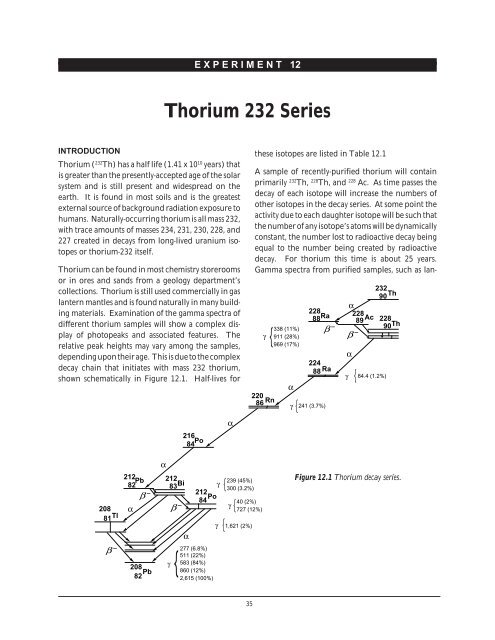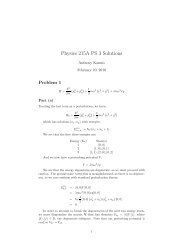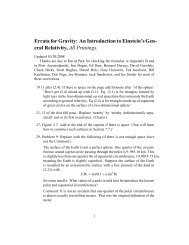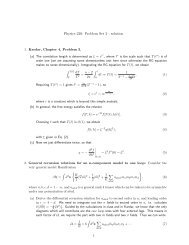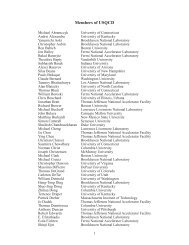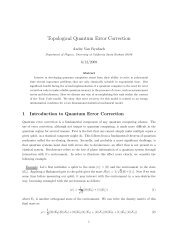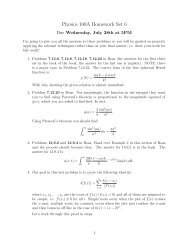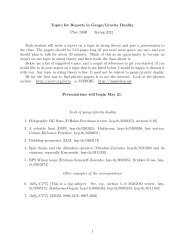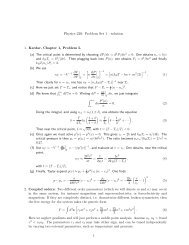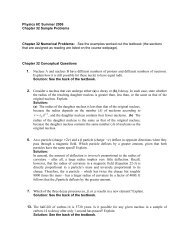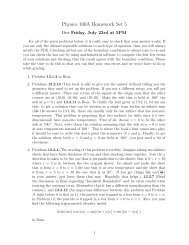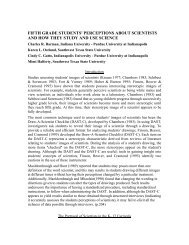Nuclear Spectroscopy
Nuclear Spectroscopy
Nuclear Spectroscopy
Create successful ePaper yourself
Turn your PDF publications into a flip-book with our unique Google optimized e-Paper software.
E X P E R I M E N T 12<br />
Thorium 232 Series<br />
INTRODUCTION<br />
Thorium ( 232 Th) has a half life (1.41 x 10 10 years) that<br />
is greater than the presently-accepted age of the solar<br />
system and is still present and widespread on the<br />
earth. It is found in most soils and is the greatest<br />
external source of background radiation exposure to<br />
humans. Naturally-occurring thorium is all mass 232,<br />
with trace amounts of masses 234, 231, 230, 228, and<br />
227 created in decays from long-lived uranium isotopes<br />
or thorium-232 itself.<br />
Thorium can be found in most chemistry storerooms<br />
or in ores and sands from a geology department’s<br />
collections. Thorium is still used commercially in gas<br />
lantern mantles and is found naturally in many building<br />
materials. Examination of the gamma spectra of<br />
different thorium samples will show a complex display<br />
of photopeaks and associated features. The<br />
relative peak heights may vary among the samples,<br />
depending upon their age. This is due to the complex<br />
decay chain that initiates with mass 232 thorium,<br />
shown schematically in Figure 12.1. Half-lives for<br />
these isotopes are listed in Table 12.1<br />
A sample of recently-purified thorium will contain<br />
primarily 232 Th, 228 Th, and 228 Ac. As time passes the<br />
decay of each isotope will increase the numbers of<br />
other isotopes in the decay series. At some point the<br />
activity due to each daughter isotope will be such that<br />
the number of any isotope’s atoms will be dynamically<br />
constant, the number lost to radioactive decay being<br />
equal to the number being created by radioactive<br />
decay. For thorium this time is about 25 years.<br />
Gamma spectra from purified samples, such as lan-<br />
γ<br />
220<br />
86 Rn<br />
338 (11%)<br />
911 (28%)<br />
969 (17%)<br />
α<br />
228<br />
88Ra<br />
228<br />
89<br />
Ac<br />
–<br />
–<br />
224<br />
88 Ra<br />
γ 241 (3.7%)<br />
β<br />
γ<br />
α<br />
β<br />
α<br />
232<br />
90<br />
Th<br />
84.4 (1.2%)<br />
228<br />
90Th<br />
216<br />
84<br />
Po<br />
α<br />
α<br />
208<br />
81Tl<br />
β<br />
–<br />
212<br />
Pb<br />
82<br />
α<br />
β<br />
–<br />
208<br />
Pb<br />
82<br />
212<br />
83<br />
Bi<br />
γ<br />
β<br />
–<br />
α<br />
γ<br />
212<br />
Po<br />
84<br />
277 (6.8%)<br />
511 (22%)<br />
583 (84%)<br />
860 (12%)<br />
2,615 (100%)<br />
239 (45%)<br />
300 (3.2%)<br />
γ<br />
40 (2%)<br />
727 (12%)<br />
γ 1,621 (2%)<br />
Figure 12.1 Thorium decay series.<br />
35


